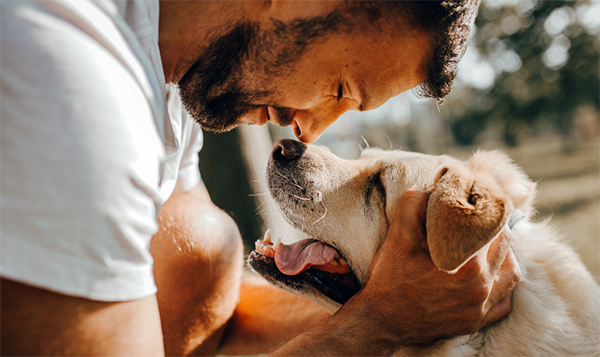We can help you avoid training mistakes and make training more fun and effective.
Part 1 in a series of 4: Solutions for Dog Training Success
Dog Training Solution #1:
If you want great training results, don’t cut corners on our 10 Tips to Success.
We have all made mistakes raising and training canine companions. (Yes, even the pros!) Hey, don’t feel bad. Sometimes we don’t know when we are making mistakes, or we take bad advice from others who don’t know much more than we do. You can easily improve if you want to do better, want what’s best for your dog, and you’re willing to learn and try new things. Yay!
Starting now, quit expecting your dog to be perfect. You may not realize how often you’ve been impeding your own progress. Start by letting go of past errors; you’re only human (and your dog forgives you!). It is not uncommon for pet parents to teach their dog a skill, the dog seems to ‘get it’ but then the dog becomes unfocused and ‘doesn’t listen’. You know what happens next, right? The dog parent gets angry, frustrated, or just repeatedly asks the dog for the same behavior thinking that it might work the sixth time. Does it? Nope.
Do any of these fit?
- You are not experiencing the training successes that you want.
- Your dog training is frustrating you.
- You want to be more effective.
- You want training results to come more quickly.
Here’s the good news: There are simple techniques that will work whether your dog is a puppy, an adult dog who is new to your home, or a dog who has been in your home for years.
10 Pro Tips for Success
Pro Tip #1 Your dog only understands what you have taught her.
Dogs don’t generalize well. For your dog to truly understand a skill, it must be taught in many different situations and environments. Here’s the problem. Your dog may understand, “down” when you cue it in your kitchen, and she does it fairly well there. But in other situations, not so much. What should you do? Get solid success in one place and then teach it in increasingly more difficult locations, slowly building many successes in various situations. This brings us to…
Pro Tip #2 Strategically choose your dog’s classroom.
The learning environment should be carefully planned. Dogs don’t think or process well when they are distracted, anxious, stressed,
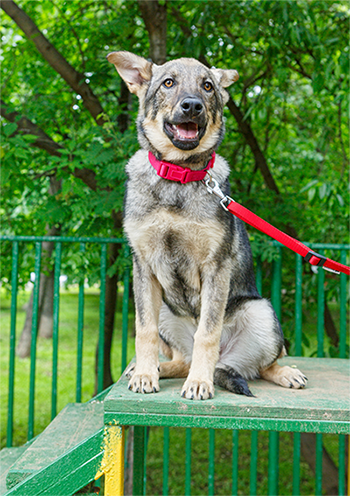
When your dog is ready, train in more challenging locations. Cody is working well in the park on ‘stay’.
scared, or over-excited. Change the situation to change your dog’s emotional state to one of calm and focus.
Start teaching your dog a skill in a quiet, non-distracting environment first (such as a room in your home). When that is going well, move to a slightly different place (such as a different room, the backyard, or the front porch, or a different area in your neighborhood. Places like the park or the store come later.). The idea is to increase the distractions slowly. If your dog is struggling in a specific environment, move further away from the distraction or leave and try again later or in a slightly different location. You are trying to build fluency for each behavior (such as sit, down, stay, etc.). Fluency is when your dog can successfully perform a specific skill or behavior 90% of the time in any situation. That takes time! It’s like learning a foreign language. Be patient and put in the effort now. It will pay off handsomely in the future.
Pro Tip #3 Your dog should be paid well.
For Pete’s sake, she’s trying hard, so motivate and encourage her with food rewards when she is successful. The food should be in tiny pieces (pea size) and hidden from view until you’re ready to give it. She’ll want to work hard for this reinforcement, so try different things and find out what your dog loves and list them from fave to meh. The harder the skill or the more distracting the environment, the yummier the food should be and the more often it should be given. Maintain motivation by asking for easy things to reinforce if she is not quite achieving success. (We will talk more about using reinforcement correctly in Part 3. Yes, it can be used incorrectly and actually slow learning!)
Watch the dog in the video. Is this dog being reinforced appropriately? His reward is being petted. Notice when he is petted he turns away. He is not enjoying the interaction so this is not an adequate reward for him. (And the choke collar and the tight leash are stressing him too.)
Pro Tip #4 Treat every day like a new day.
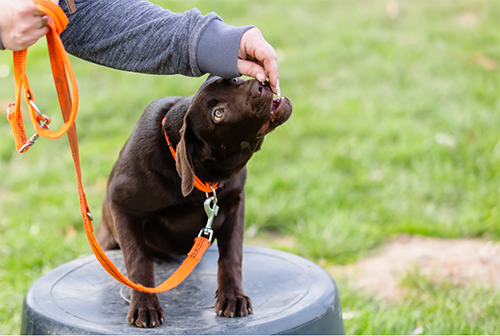
Build confidence in new situations. Work slowly to create success. Make it easier when needed. Young Charlee is happily working.
Your dog’s ability to learn and his emotional state are fluid. Some days you may have to back up a few steps in training if you see your dog struggling. It’s not a failure, it’s a step toward helping your dog succeed. Think about when you had to learn a new skill such as a musical instrument, a foreign language, or a sport. Some days it seemed easy and on other days you had to apply more effort. Be consistent in your efforts by setting adjustable goals and planning ahead.
Pro Tip #5 Continually adjust your criteria and expectations.
You need to strategically modify your expectations of your dog’s performance to move forward successfully.
When your dog makes a mistake, it’s information for you. Has he failed two repetitions of a lesson in a row? Make the exercise easier. For example, you cued him to ‘stay’ and backed away a few feet. He immediately popped up to follow. You tried again and he repeated this same error. Do you get mad, yell at him that he knows this, and try the exact same thing again? What would that accomplish besides stressing you both? Instead, make it a little easier. How about backing up one step and returning quickly to reinforce him so that he can comfortably succeed? Did that work? If not, try a half step or just lean backward and immediately forward again and reinforce him for doing so well! You’ve just helped him succeed! When he handles this skill successfully 4-5 times in a row, that’s the time to make it a little harder.
Above all, don’t punish your dog’s mistakes with leash yanks, reprimands, or an annoyed or angry tone (even if you’re only frustrated with yourself). Stress is a learning killer and punishment causes tons of stress. (And didn’t we all hate that teacher who thought embarrassing a student for a wrong answer was a good teaching technique? How many times would you try again after that?) Remember, YOU are your dog’s teacher. It is the teacher who is responsible for figuring out what the student needs to help him or her learn.
Notice how worried the dog in the video is. She is turning away, panting, and scanning the environment. This is not an ideal learning situation for her.
Pro Tip #6 Timing!
It’s important to be timely with your reinforcement. Here’s an example. You want to train your dog to focus on you outside. To capture and build that skill, wait patiently in a quiet spot until she looks at you. The exact moment she does should be marked (clicked or using a verbal marker like, “yes!”) and then reinforced. But if she looks at you and you don’t respond with reinforcement, or you reinforce when she is then looking at something else, you will have ineffectively communicated the exact behavior you want. That is going to take a longer time to teach for sure. So, practice telling her she’s great at the precise moment she does the right thing. It’s like taking a picture. If you click the shutter at the wrong time, you’ve totally missed the action!
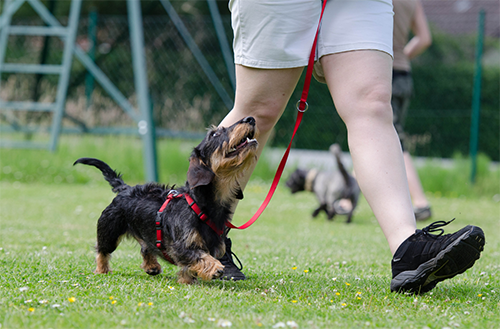
Correct training and reinforcement create a focused, happy-to-work dog!
Pro Tip #7 Don’t throw everything at your dog at once and expect success.
Let’s say you want your dog to learn to stay (remain in a specific position such as a down) for a minute, in a distracting environment, and with you out of sight or at a distance. Do you practice all of that at once and expect success? Do you, for example, increase the time between treats to a minute (Duration), while you walk 20’ away (Distance), while another dog is walking past (Distraction)? Really? That will fail every time in the unskilled dog. Instead, work on one of those 3 Ds at a time (in many cases, concentrating on some duration first). Build each one up individually and then slowly put them together (see Pro Tip #5). As they are built, each element is made easier so that only one of them is really challenging or difficult for your dog at a time. (Read the article on Using the 3 Ds to Supercharge Your Training.)
Pro Tip #8 Make training a part of your life.
Many of my students do not train their dogs often enough simply because they are busy, and don’t think they have the time. They think that a daily training session needs to be at least 30-60 minutes long. (What? Then my own dogs would be abject dummies! Who has that kind of time every day?)
Training should simply be a part of your life. You may have the time for 5 repetitions of ‘down’ while you are getting ready for work. Or you ask for a stay when you are fixing your dog’s dinner. Or you want a sit before your dog exits a door or waits patiently for the toy to be thrown. Or you click for attention on walks. Integrate training into all the moments of life that you are with your dog, whether that’s a 30-second session or 20 minutes because the two of you are having so much fun together building training into playtime! (How about training while you exercise? That’s a twofer!)
Pro Tip #9. Allow your dog time to think.
Don’t be so quick to repeat things over and over. If you have chosen the learning environment correctly, and adjusted for the right level of distractions, allow your dog to process what you’ve asked for and to try to work things out. Be quick to reinforce correct responses, sometimes even baby steps in the right direction. Or, if everything is set up for your dog’s success, ask a maximum of twice and then stop, wait, and see if he responds. If not, walk away and try again a short time later. Don’t inadvertently train your dog to ignore you or respond slowly. (Reread Pro Tips #2 and #4.)
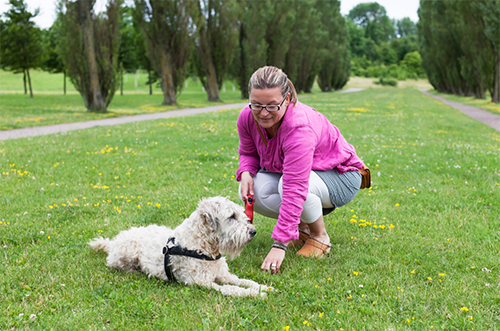
If your dog is too distracted to concentrate, pause and see if she will process what you’ve asked for. If not, move her to a different location to try again.
Pro Tip #10 Have fun! Enjoy the process.
It’s a joy to watch your dog learn, grow, and succeed. It’s fascinating to observe how your dog figures things out, how his brain processes information. Be a part of this wonderful journey together.
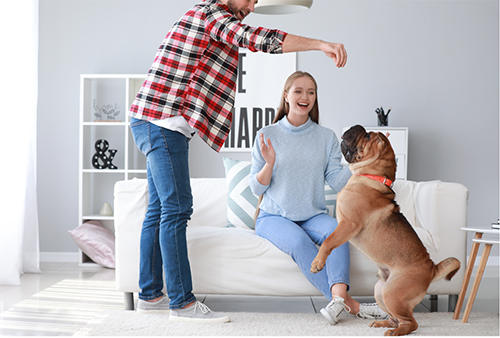
Include the whole family to share the fun!
Thanks for reading Part 1. Check out all 4 articles for great training success and solutions.
- Part 2: Don’t Be Judgy. Toss Those Labels! Labeling your dog negatively has a way of supporting that personality trait. (For example, have you ever called your dog stubborn? We will explore that and other labels and why they often mean something completely different.)
- Part 3: Use Reinforcement for Magical Results. Use reinforcement accurately, correctly, and strategically so it works and does not become a crutch or a distraction.
- Part 4: Choice Creates Canine Confidence. Allow your dog to have independent thought and make choices. (What? I thought I had to tell my dog what to do to get what I want? Guess what? Strategically chosen choices build impulse control and confidence.)

